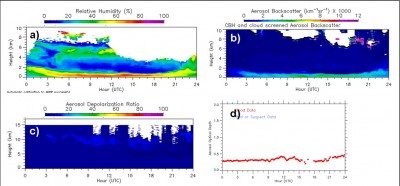Raman Lidar Data Product Suite Provides Best-Estimate Data
Published: 14 October 2011

Science data products derived from the Raman lidar (RL) are produced using a suite of five value-added product (VAP) processes. These VAP processes, jointly known as RLPROF, are run together to produce estimates of:
- water vapor mixing ratio
- relative humidity
- aerosol scattering ratio
- aerosol volume backscatter coefficient
- aerosol extinction
- aerosol linear depolarization ratio
- cloud mask
- aerosol optical depth
- precipitable water vapor.
Once the suite of RLPROF VAP processes produce these primary measurements, the RLPROF best-estimate (RLPROF-BE) product is created and provides all the listed measurements in one datastream for the Southern Great Plains Central Facility and Tropical Western Pacific Darwin site. In addition to these primary science variables, these VAPs provide error estimates and quality checks.
RLPROF was developed in an effort to simplify the output and consolidate the primary variables from the other RL VAPs into a single data file. As such, the best-estimate VAP process represents the final stage in the Raman lidar data processing chain. The output contains only the primary science variables and associated data quality parameters, while excluding much of the ancillary data contained in the other RL VAPs.
More information on RLPROF is available at the VAP web page. To access these data, log in to the Data Archive. (Go here to request an account.)
The ARM Climate Research Facility is a DOE Office of Science user facility. The ARM Facility is operated by nine DOE national laboratories, including .
Keep up with the Atmospheric Observer
Updates on ARM news, events, and opportunities delivered to your inbox
ARM User Profile
ARM welcomes users from all institutions and nations. A free ARM user account is needed to access ARM data.


















